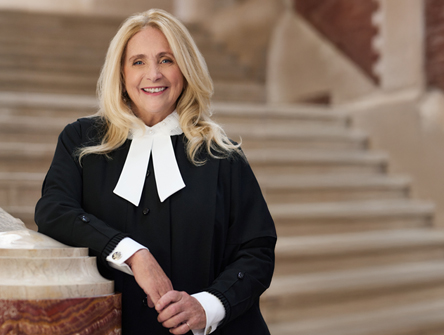Lost
How a triage system could point people seeking legal help in the right direction.

In this ongoing series, National explores some of the issues arising from the CBA Access to Justice Committee’s final report.
Most of us have several options available when we get sick, based on our assessment of how sick we are: we can buy over-the-counter remedies at a drugstore, or talk to a pharmacist; call a provincial help line to get advice from a nurse practitioner; go to the family doctor or to a clinic; or visit a hospital emergency room.
Any one of these can provide a solution, advice, or a referral to a professional who can solve the problem.
If only problem-solving in the legal system was so easy.
“Virtually everything that people do — buying and selling and gaining employment and losing employment, all the normal transactions and transitions of life — have legal aspects and potentially can turn into legal problems,” says Ab Currie, Senior Research Fellow at the Canadian Forum on Civil Justice and a member of the National Action Committee on Access to Justice in Civil and Family Matters’ Triage and Referral Working Group.
“People [often] don’t recognize the legal nature of their problems — they don’t know where to go for help; they don’t know what their rights are and often they’re just fearful of doing anything.”
One possible solution is the development of effective triage systems, an approach recommended by both the National Action Committee and the CBA’s Access to Justice Committee’s final report. It involves training professionals at all points of entry into the justice system to help people navigate their way around it.
Courts and tribunals only resolve a small fraction of civil legal disputes, says John Sims, current chair of CBA’s Access to Justice Committee. Most everyday legal problems are resolved informally: people seek advice from a variety of sources ranging from the internet to their neighbours; or they resort to negotiation or mediation, he says.
“The problem is that, when they first encounter … the legal system, people often find it overwhelming. There are literally hundreds of different informal services from which to choose. They don’t know where to turn for help.”
People generally gain access to the justice system through services they approach for other problems — through trusted intermediaries such as health-care providers or social workers, says the CBA report Envisioning Equal Justice: An invitation to envision and act, published last fall.
“The disadvantages are that it is uncertain where people will actually seek help, and their success often relies on their degree of resilience and willingness to keep knocking on different doors, repeating their stories, until they finally resolve the matter. With each additional step, more people become discouraged and many give up, often at a significant personal cost.”
Karen Hudson, executive director of Legal Aid Nova Scotia, says even she was surprised to learn that people experiencing a family breakdown often will turn up at the local courthouse seeking help.
That might be because for many the courthouse is a bricks-and-mortar representation of justice. But there’s no guarantee people will find the help they need there.
“They end up standing at the window of a clerk’s office and asking that clerk ‘what do I do about this issue’ and the clerk has limited time and limited resources to be able to assist them,” says Trish Hebert, a lawyer with Gordon Zwaenepoel in Edmonton and an ex-officio member of the CBA’s Access to Justice Committee.
Meanwhile, that person “may have asked 15 other people that same question already by the time they get to the clerk’s window.”
At this stage, triage is still just a concept that’s starting to gain attention; there is no one vision of what it looks like, or whether a single vision would even make sense for Canada’s widely varied jurisdictions.
“It’s a word that we toss around in our access to justice circles and sometimes we do need to stop and make a check and determine if we’re speaking about the same things,” says Hebert. “If we’re talking about court-based triage, are we really just talking about how we funnel people into particular processes within the formal legal structure?” she asks.
The CBA report suggests looking more broadly at the court’s role in directing people internally to the right processes, and also externally, acting as a referral network to community services or alternative dispute resolution mechanisms, she adds.
“It’s not as if the court is going to become the clearing house for every potential difficulty, but let’s give the court better ability to do that for the people who do find the courthouse as their way of accessing legal information or legal resources.”
For Currie, “triage is an active process of having somebody in a position where they can spot a problem, assess it and then tell people where to go.” It should be able to provide people with concrete help. He’d like to see it start at the very early stages of what the CBA report calls a “justiciable” problem —something at least 45 per cent of Canadians will experience in a three-year period.
For Hudson, triage means providing responses appropriate to the needs of the person seeking assistance.
“It’s a continuum,” she says. “At the front end of the continuum you have prevention and information and then collaboration and ADR approaches, and then you have more formal court processes. Some matters will have to get to the formal court process right away, other matters might never need to get into a judge if there is the option of having collaborative law/mediation/alternative dispute resolution.”
Legal aid clinics in Ontario are developing partnerships with community organizations and other service providers, says Sims.
“One promising approach to triage that is being tried in some locales is to equip these ‘trusted intermediaries’ with enough basic information and training that they can help direct people with legal problems to an appropriate person or place to get help,” he says. Other possible solutions include legal hotlines, or single-point-of-entry justice access centres.
At the end of January, Alberta Justice Minister Jonathan Denis announced that province had approved a plan to establish “triage desks” in courthouses that will help civil litigants navigate their way around the system, perhaps saving them the cost of a lawyer, which in turn will free up the courts to concentrate on matters that require that expertise.
No matter what form the system takes, what’s important is that it have answers for anyone who seeks them.
“We think of there being no wrong window to go to, so that everybody … has access to a good, effective triage and referral system,” says Hebert. “Whatever service that individual needs, they can get (it) when they knock on that door or open that window.”


